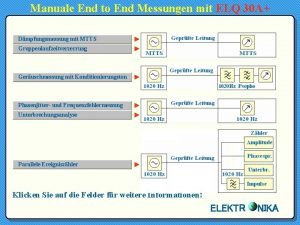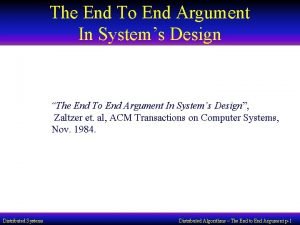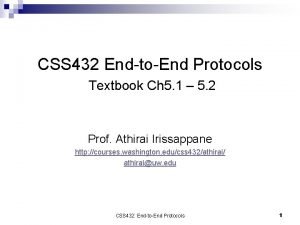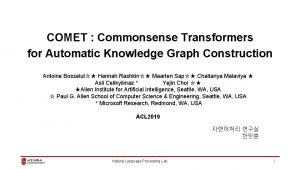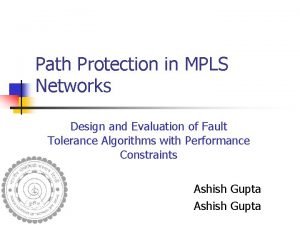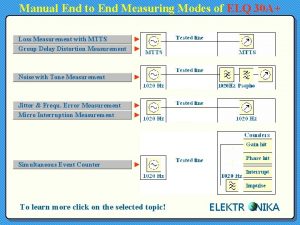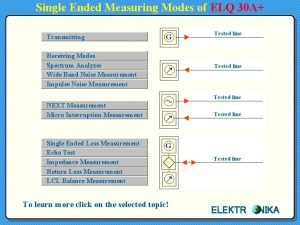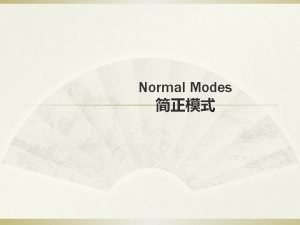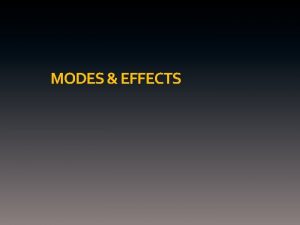Manual End to End Measuring Modes of ELQ








- Slides: 8

Manual End to End Measuring Modes of ELQ 30 A Loss Measurement with MTTS ► Group Delay Distortion Measurement ► Noise with Tone Measurement ► Jitter & Frequ. Error Measurement Micro Interruption Measurement ► ► Simultaneous Event Counter ► To learn more click on the selected topic! ELEKTR NIKA

Loss Measurement with Multi Tone Test Signal (MTTS) ELQ 30 A in MTTS mode provides: ■ Transmitting 30 to 35 frequencies at the same time ■ Receiving 30 to 35 frequencies at the same time The advantages of MTTS : ■ Quick and comfortable ■ No synchronization is necessary between transmitter and far end receiver Selectable ranges ELEKTR NIKA

Group Delay Distortion Measurement ELQ 30 A The group delay distortion measurement needs two ELQ 30 A instruments connected to the ends of the tested line. One of them transmits a test tone the other one receives and evaluates it. ELQ 30 A applies: The multi tone test (MTTS) method described in the recommendation ITU-T O. 81 Appendix I. ELQ 30 A performs Group delay distortion and level measurements simultaneously. ELEKTR NIKA

Noise Measurement with Conditioning Tone ELQ 30 A The noise measurement of PCM systems requires an 1020 Hz conditioning tone applied to the far end of the tested line. At the near end where he noise measurement is performed the conditioning tone should be suppressed with an 1020 Hz notch filer. ELQ 30 A in Noise with Tone mode provides: ■ 1020 Hz conditioning tone generation ■ Noise measurement with Psophometric filter and 1020 conditioning tone ELEKTR NIKA

Phase Jitter & Frequency Error Measurement ELQ 30 A The jitter and frequency error measurement needs two ELQ 30 A instruments connected to the ends of the tested line. One of them transmits a jitter free quartz accurate 1020 Hz test tone the other one receives and evaluates it. ELQ 30 A performs the two measurements simultaneously according to rec. ITU-T O. 91 ELEKTR NIKA

Micro Interruption Measurement ELQ 30 A The interruption analysis needs two ELQ 30 A instruments connected to the ends of the tested line. One of them transmits 1020 Hz test tone the other one receives it and detects the micro interruptions according to rec. ITU-T O. 62. An interruption is detected when the level of the received test tone drops below a designated threshold for more than 0. 6 ms. Short form information Histogram List The measuring time is adjustable between 5 min and 72 hours. ELEKTR NIKA

Simultaneous Event Counter The event test needs two ELQ 30 A instruments connected to the ends of the tested pair. One of them transmits a test tone the other one receives it and simultaneously counts the number of events like: ■ Amplitude hits (described in rec. ITU-T O. 95) ■ Phase hits (described in rec. ITU-T O. 95) ELQ 30 A ■ Interruptions (described in rec. ITU-T O. 61) ■ Noise impulses (described in rec. ITU-T O. 71) ELQ 30 A Measuring times: 5, 15, 30, 60 min Maximum count: 65000 for each counter ELEKTR NIKA

THANK YOU FOR YOUR ATTENTION!
